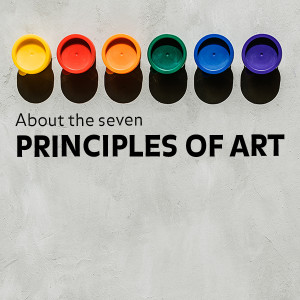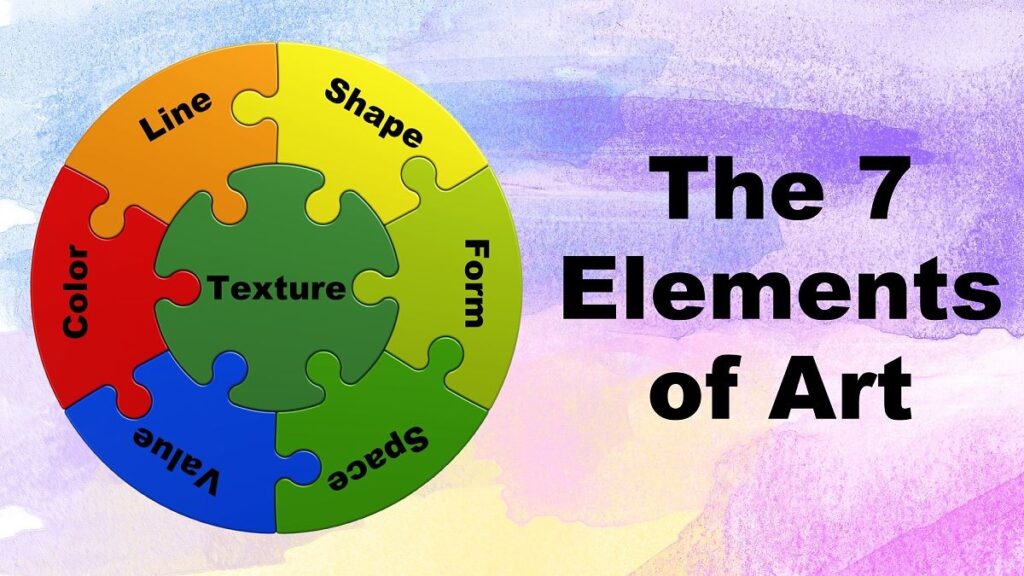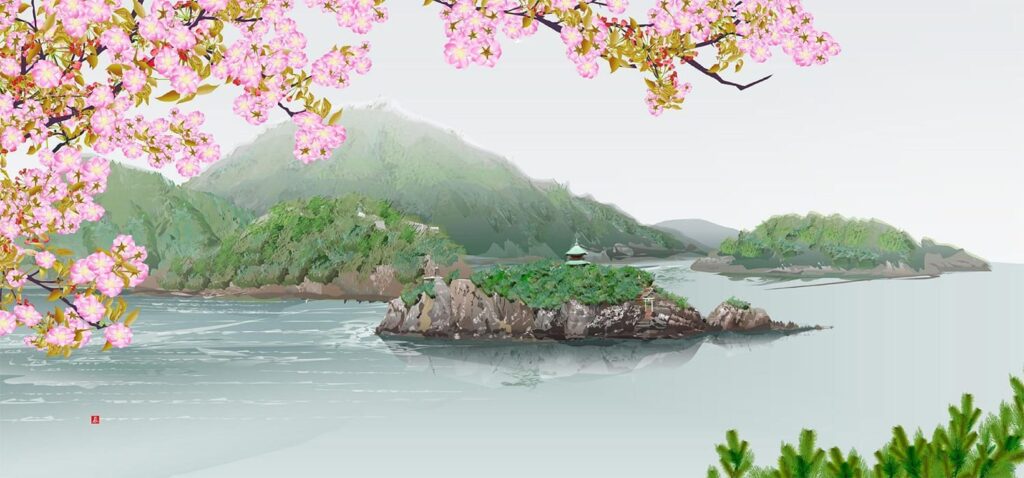Unity in art refers to the sense of oneness or harmony achieved through the arrangement of various elements within a piece.
Just like in Gestalt psychology where your mind finds patterns and connections, in art, unity emerges when different parts come together to create a cohesive whole.
In art, unity isn’t just about making things look good together; it’s about creating a visual experience that feels complete and harmonious. To achieve this, artists employ five types of unity: proximity, similarity, continuation, closure, and figure-ground relationship.
Each of these techniques plays a role in bringing together disparate elements into a unified whole, captivating the viewer and evoking a sense of wholeness and coherence.
What is Unity in Art?

Unity in art refers to the seamless blending of various elements within a piece, creating a cohesive and harmonious whole.
Imagine it like putting together a puzzle, where every piece fits together perfectly to form the complete picture.
However, achieving unity doesn’t mean everything has to be the same.
Variety can also be incorporated to add interest and depth to the artwork.
Sometimes, artists deliberately introduce elements of contrast or tension to evoke specific emotions or responses from the viewer.
7 Principles Of Art

You can learn more about the other principles and elements of art in the linked articles below.
- Balance
- Contrast and Emphasis
- Movement and Rhythm
- Unity and Variety (we are reading about Unity now!)
- Harmony
- Pattern
- Proportions and Scale
7 Elements of Art

How To Achieve Unity in Art?

When creating art, achieving unity is crucial for a harmonious and balanced composition.
Unity can be attained through various means, such as simplicity, proximity, repetition, alignment, and continuation.
These are like tools in an artist’s toolbox, each serving a purpose in bringing cohesion to the artwork.
However, unity isn’t just about following a set of rules; it’s about cultivating artistic intuition and ensuring that all elements in the artwork work together seamlessly.
While there are guidelines to follow, artists often develop their own unique methods and styles for achieving unity, making it a personal and integral aspect of their creative process.
Let’s delve into these five compositional tools to understand how they contribute to the overall unity of an artwork.
Simplicity
Achieving unity in art is like creating harmony within a piece, making all its parts work together smoothly.
One key way to do this is by keeping things simple. When we talk about simplicity in art, we mean using fewer elements or limiting certain aspects of the artwork.
For instance, imagine a painting with just straight lines all going in the same direction, or one with only a few colors, sticking to a monochrome scheme.
Even having just a couple of textures throughout the artwork can add to this simplicity. Basically, it’s about sticking to a theme or a consistent style throughout your creation.
So, to achieve unity in art, think about simplifying things. Focus on a few key elements and let them work together to create something greater than the sum of its parts.
Proximity
Achieving unity in art is like bringing different puzzle pieces together to create a harmonious picture. One way to do this is through proximity.
Proximity means putting things close to each other in a picture. When objects or figures are near each other, our brains tend to see them as one big group rather than separate pieces.
Think about it like arranging your toys on a shelf. When they’re all close together, they look like they belong together. In art, this closeness helps create a sense of togetherness and connection.
Sometimes, though, things might be far apart in a picture. That’s where a third element, like a road or a line, comes in handy. It acts like a bridge, connecting those distant pieces and making them feel united.
So, in short, by bringing things closer together and using connecting elements, you can achieve unity in art. It’s like gathering all the pieces of a puzzle to make a beautiful whole.
Repetition
Achieving unity in art is like bringing all the pieces of a puzzle together to create a harmonious picture. One way to do this is through repetition.
Repetition means using the same or similar shapes, colors, textures, or values throughout your artwork. It’s like using a pattern over and over again. This repetition ties everything together and makes the different parts of your artwork feel connected.
So, to achieve unity in art, remember to repeat elements like colors, shapes, or patterns throughout your artwork. This repetition helps to bring everything together and create a cohesive and unified piece.
Alignment
Think of alignment like putting puzzle pieces together.
When shapes or elements in a piece of art are aligned in a way that their lines or edges lead into each other, it helps the viewer’s eye to connect them. This creates a sense of togetherness or unity.
In everyday life, you can see alignment unity in things like magazine layouts or websites. When the content is organized in a grid or structure, it guides your eyes in a specific path, making everything feel cohesive.
By paying attention to alignment and how elements interact with each other, artists can create a sense of unity that ties their work together beautifully.
Continuation
To achieve unity in art, you can focus on continuity. Continuity means making everything in your artwork flow together smoothly.
You can do this by connecting edges, shapes, and lines so that they lead from one part of the artwork to another. This makes the whole piece feel connected and not choppy or disjointed.
One cool trick to create continuity is by using implied lines. These are lines that aren’t actually drawn but are suggested by the arrangement of shapes and objects. They help guide the viewer’s attention throughout the artwork, tying everything together.
So, if you want your art to feel unified, pay attention to how different parts connect and flow into each other. This way, your artwork will feel cohesive and complete.
How to Create Unity In Your Own Art?

To bring unity into your own art, follow these steps:
- Visualize Your Concept: Start by forming a clear idea in your mind. Understand what you want to create and how it will look. Decide if it’s going to be abstract or realistic, and think about which techniques, principles, and elements of art you’ll use.
- Sketch Your Ideas: Sketching is crucial. It helps you figure out the initial composition and experiment with different approaches to unity. Try out various options until you find what suits your vision best.
- Create Your Art: Now it’s time to bring your vision to life. As you work, be open to making adjustments if you think of better solutions. Pay close attention to how unity develops throughout the creative process.
- Practice and Experiment: Achieving unity in your art takes practice. Don’t be afraid to make mistakes along the way. Trust your intuition, and keep refining your skills by experimenting with different elements and principles.
FAQ’s:
Why is Unity in Art Important?
Unity in art is important because it brings all seven principles of art together into a harmonious and cohesive artwork. It is responsible for clearly conveying the message behind an art piece, disallowing confusion.
What is Unity and Variety in Art?
Unity and variety in art is one of the seven principles of art that are responsible for the harmonious arrangement of art elements within a design while using the seven visual art elements to create interest, contrast, and complexity in the artwork . Unity and variety in art are sometimes considered one principle, and sometimes as separate principles.
What is the Difference Between Unity and Variety?
Unity and variety are two important design principles. Unity refers to the sense of wholeness in a work of art, meaning that everything looks like it belongs together. Variety, on the other hand, refers to using different elements to create variety and diversity. The best art uses both and finds a happy balance between the two.
Is Harmony the Same as Unity in Art?
Harmony and unity are often used as interchangeable terms, however in art, they mean different things. Unity refers to the wholeness of composition, and harmony to the components within it.
Harmony refers to the pleasing combination of pieces in a work of art, such as colors, shapes, and textures.
While harmony focuses on the relationship between individual parts of the image, unity considers how those elements work together to create a single, cohesive whole.
Conclusion
In summary, unity in art is like orchestrating a symphony where each instrument plays its part to create a harmonious melody.
It’s about bringing together various elements, whether through proximity, repetition, alignment, or continuation, to form a cohesive whole that captivates the viewer’s eye and evokes a sense of completeness.
Just as a puzzle comes together to reveal a complete picture, unity in art ensures that every brushstroke, line, color, and form contributes to the overall composition, guiding the viewer through a seamless visual journey.
By understanding and mastering the principles of unity, artists can transform a mere collection of elements into a unified masterpiece that speaks volumes to the observer.
So, whether you’re sketching, painting, or sculpting, remember that unity is the glue that binds your artistic vision, creating a work of art that is greater than the sum of its parts.


Leave a Reply